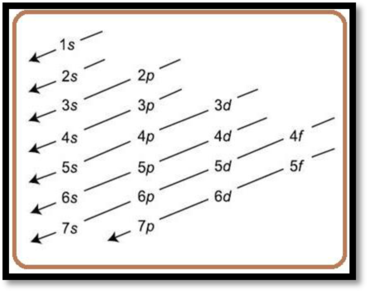
Connect 1-Semester Access Card for General, Organic, and Biochemistry
9th Edition
ISBN: 9781259815096
Author: Katherine J Denniston, Joseph J Topping, Dr Danae Quirk Dorr
Publisher: McGraw-Hill Education
expand_more
expand_more
format_list_bulleted
Question
Chapter 2, Problem 2.88QP
(a)
Interpretation Introduction
Interpretation:
The electronic configuration and orbital diagram of Vanadium has to be written.
Concept Introduction:
Electron configuration: The complete description of the atomic orbital occupied by all the electrons in an atom is known as electron configuration.
Aufbau principle says that electron fills the lowest energy level before filling the higher ones.

Figure 1
(b)
Interpretation Introduction
Interpretation:
The electron configuration and orbital diagram of Cadmium has to be written.
Concept Introduction:
Refer Part (a).
(c)
Interpretation Introduction
Interpretation:
The electron configuration and orbital diagram of Tellurium atom has to be written.
Concept Introduction:
Refer Part (a).
Expert Solution & Answer
Want to see the full answer?
Check out a sample textbook solution
Students have asked these similar questions
Q4: Rank the relative nucleophilicity of halide ions in water solution and DMF solution,
respectively.
F CI
Br |
Q5: Determine which of the substrates will and will not react with NaSCH3 in an SN2 reaction to
have a reasonable yield of product.
NH2
Br
Br
Br
OH
Br
Q7: Rank the following groups in order of basicity, nucleophilicity, and leaving group ability.
a) H₂O, OH, CH3COOT
b) NH3, H₂O, H₂S
Q8: Rank the following compounds in order of increasing reactivity in a nucleophilic substitution
reaction with CN as the nucleophile.
Br
A
B
NH2
LL
F
C
D
OH
CI
LLI
E
Q9: Complete the missing entities for following reactions (e.g., major product(s), reactants,
and/or solvents) for the SN2 reactions to occur efficiently. Include curved-arrow mechanism for
reactions a) to d).
a)
H
"Cl
D
+
-OCH 3
Page 3 of 5
Chapter 2 Solutions
Connect 1-Semester Access Card for General, Organic, and Biochemistry
Ch. 2.1 - Calculate the number of protons, neutrons, and...Ch. 2.1 - How many protons, neutrons, and electrons are...Ch. 2.1 - How many protons, neutrons, and electrons are...Ch. 2.1 - The element nitrogen has two naturally occurring...Ch. 2.1 - Prob. 2.3PPCh. 2.3 - Prob. 2.3QCh. 2.3 - Prob. 2.4QCh. 2.4 - Prob. 2.5QCh. 2.4 - Using the periodic table, write the symbol for...Ch. 2.4 - Refer to the periodic table, and find the...
Ch. 2.4 - Refer to the periodic table, and find the...Ch. 2.4 - Prob. 2.9QCh. 2.4 - For each of the following element symbols, give...Ch. 2.5 - Prob. 2.4PPCh. 2.5 - Prob. 2.5PPCh. 2.5 - Prob. 2.6PPCh. 2.6 - Prob. 2.7PPCh. 2.6 - Prob. 2.8PPCh. 2.6 - Determine the number of protons and electrons in...Ch. 2.6 - Prob. 2.12QCh. 2.6 - Prob. 2.9PPCh. 2.6 - Prob. 2.13QCh. 2.6 - Prob. 2.14QCh. 2.6 - Provide the charge of the most probable ion...Ch. 2.6 - Prob. 2.15QCh. 2.6 - Which of the following pairs of atoms and ions are...Ch. 2.7 - Prob. 2.17QCh. 2.7 - Prob. 2.18QCh. 2 - Prob. 2.19QPCh. 2 - Why is the number of electrons not part of the...Ch. 2 - Fill in the blanks:
Isotopes of an element differ...Ch. 2 - Identify which of the following isotopic symbols...Ch. 2 - Identify the major difference and the major...Ch. 2 - Label each of the following statements as true or...Ch. 2 - Label each of the following statements as true or...Ch. 2 - The nuclei of three different atoms are depicted...Ch. 2 - Calculate the number of protons, neutrons, and...Ch. 2 - Calculate the number of protons, neutrons, and...Ch. 2 - An atom has nine protons, ten neutrons, and nine...Ch. 2 - An atom has nineteen protons, twenty neutrons, and...Ch. 2 - How many protons are in the nucleus of the isotope...Ch. 2 - Prob. 2.32QPCh. 2 - Selenium-80 is a naturally occurring isotope used...Ch. 2 - Prob. 2.34QPCh. 2 - Write symbols for each isotope:
Each atom contains...Ch. 2 - Prob. 2.36QPCh. 2 - The element copper has two naturally occurring...Ch. 2 - The element lithium has two naturally occurring...Ch. 2 - Prob. 2.39QPCh. 2 - Prob. 2.40QPCh. 2 - Describe the experiment that provided the basis...Ch. 2 - Prob. 2.42QPCh. 2 - Prob. 2.43QPCh. 2 - Prob. 2.44QPCh. 2 - Prob. 2.45QPCh. 2 - Prob. 2.46QPCh. 2 - Prob. 2.47QPCh. 2 - Prob. 2.48QPCh. 2 - Prob. 2.49QPCh. 2 - Prob. 2.50QPCh. 2 - Prob. 2.51QPCh. 2 - Prob. 2.52QPCh. 2 - Describe electromagnetic radiation according to...Ch. 2 - Prob. 2.54QPCh. 2 - Is the following statement true or false?
Light of...Ch. 2 - Prob. 2.56QPCh. 2 - Prob. 2.57QPCh. 2 - Prob. 2.58QPCh. 2 - Describe the process that occurs when electrical...Ch. 2 - When electrical energy is applied to an element in...Ch. 2 - Prob. 2.61QPCh. 2 - Prob. 2.62QPCh. 2 - Prob. 2.63QPCh. 2 - Prob. 2.64QPCh. 2 - What was the major contribution of Bohr’s atomic...Ch. 2 - What was the major deficiency of Bohr’s atomic...Ch. 2 - Provide the atomic number, atomic mass, and name...Ch. 2 - Provide the atomic number, atomic mass, and name...Ch. 2 - Prob. 2.69QPCh. 2 - Prob. 2.70QPCh. 2 - Which group of the periodic table is known as the...Ch. 2 - Prob. 2.72QPCh. 2 - For each of the elements Na, Ni, Al, P, Cl, and...Ch. 2 - Prob. 2.74QPCh. 2 - Prob. 2.75QPCh. 2 - Prob. 2.76QPCh. 2 - Distinguish between a principal energy level and a...Ch. 2 - Distinguish between a sublevel and an orbital.
Ch. 2 - Sketch a diagram and describe our current model of...Ch. 2 - How is a 2s orbital different from a 1s orbital?
Ch. 2 - Prob. 2.81QPCh. 2 - For any given principal energy level, what is the...Ch. 2 - State the Pauli exclusion principle. Explain how...Ch. 2 - State Hund’s rule. Determine whether the following...Ch. 2 - Using the periodic table, write the electron...Ch. 2 - Using the periodic table, write the electron...Ch. 2 - Using the periodic table, write the electron...Ch. 2 - Using the periodic table, write the electron...Ch. 2 - Which of the following electron configurations are...Ch. 2 - Prob. 2.90QPCh. 2 - Determine whether the following orbital diagrams...Ch. 2 - Identify the element for each of the orbital...Ch. 2 - Use the periodic table and determine the shorthand...Ch. 2 - Prob. 2.94QPCh. 2 - Prob. 2.95QPCh. 2 - Prob. 2.96QPCh. 2 - State the octet rule.
Ch. 2 - Prob. 2.98QPCh. 2 - Prob. 2.99QPCh. 2 - Prob. 2.100QPCh. 2 - How many total electrons and valence electrons are...Ch. 2 - Prob. 2.102QPCh. 2 - Prob. 2.103QPCh. 2 - Prob. 2.104QPCh. 2 - Prob. 2.105QPCh. 2 - Predict the number of valence electrons in an atom...Ch. 2 - Prob. 2.107QPCh. 2 - Prob. 2.108QPCh. 2 - Prob. 2.109QPCh. 2 - Prob. 2.110QPCh. 2 - Prob. 2.111QPCh. 2 - Prob. 2.112QPCh. 2 - Prob. 2.113QPCh. 2 - Prob. 2.114QPCh. 2 - Prob. 2.115QPCh. 2 - Prob. 2.116QPCh. 2 - Prob. 2.117QPCh. 2 - Prob. 2.118QPCh. 2 - Prob. 2.119QPCh. 2 - Prob. 2.120QPCh. 2 - Prob. 2.121QPCh. 2 - Prob. 2.122QPCh. 2 - Prob. 2.123QPCh. 2 - Prob. 2.124QPCh. 2 - Explain why a positive ion is always smaller than...Ch. 2 - Prob. 2.126QPCh. 2 - Prob. 2.127QPCh. 2 - Prob. 2.128QPCh. 2 - A natural sample of chromium, taken from the...Ch. 2 - Prob. 2CPCh. 2 - Prob. 4CP
Knowledge Booster
Learn more about
Need a deep-dive on the concept behind this application? Look no further. Learn more about this topic, chemistry and related others by exploring similar questions and additional content below.Similar questions
- Q10: (a) Propose a synthesis of C from A. (b) Propose a synthesis of C from B. Br Br ...\SCH 3 A B Carrow_forward9: Complete the missing entities for following reactions (e.g., major product(s), reactants, and/or solvents) for the SN2 reactions to occur efficiently. Include curved-arrow mechanism for reactions a) to d).arrow_forwardComplete the missing entities for following reactions (e.g., major product(s), reactants, and/or solvents) for the SN2 reactions to occur efficiently. Include curved-arrow mechanism for reactions a) to d).arrow_forward
- QUESTION 3: Provide the synthetic steps that convert the starting material into the product (no mechanism required). HO OH NH CH3 multiple steps 요요 H3Carrow_forwardQ6: Predict the effect of the changes given on the rate of the reaction below. CH3OH CH3Cl + NaOCH3 → CH3OCH3 + NaCl a) Change the substrate from CH3CI to CH31: b) Change the nucleophile from NaOCH 3 to NaSCH3: c) Change the substrate from CH3CI to (CH3)2CHCI: d) Change the solvent from CH3OH to DMSO.arrow_forwardQ3: Arrange each group of compounds from fastest SN2 reaction rate to slowest SN2 reaction rate. a) CI Cl فيكم H3C-Cl A B C D Br Br b) A B C Br H3C-Br Darrow_forward
- Q2: Group these solvents into either protic solvents or aprotic solvents. Acetonitrile (CH3CN), H₂O, Acetic acid (CH3COOH), Acetone (CH3COCH3), CH3CH2OH, DMSO (CH3SOCH3), DMF (HCON(CH3)2), CH3OHarrow_forwardSuppose the rate of evaporation in a hot, dry region is 1.76 meters per year, and the seawater there has a salinity of 35 ‰. Assuming a 93% yield, how much salt (NaCl) can be harvested each year from 1 km2 of solar evaporation ponds that use this seawater as a source?arrow_forwardhelparrow_forward
- Explain why only the lone pairs on the central atom are taken into consideration when predicting molecular shapearrow_forward(ME EX1) Prblm #9/10 Can you explain in detail (step by step) I'm so confused with these problems. For turmber 13 can u turn them into lewis dot structures so I can better understand because, and then as well explain the resonance structure part. Thanks for the help.arrow_forwardProblems 19 and 20: (ME EX1) Can you please explain the following in detail? I'm having trouble understanding them. Both problems are difficult for me to explain in detail, so please include the drawings and answers.arrow_forward
arrow_back_ios
SEE MORE QUESTIONS
arrow_forward_ios
Recommended textbooks for you
 ChemistryChemistryISBN:9781305957404Author:Steven S. Zumdahl, Susan A. Zumdahl, Donald J. DeCostePublisher:Cengage Learning
ChemistryChemistryISBN:9781305957404Author:Steven S. Zumdahl, Susan A. Zumdahl, Donald J. DeCostePublisher:Cengage Learning ChemistryChemistryISBN:9781259911156Author:Raymond Chang Dr., Jason Overby ProfessorPublisher:McGraw-Hill Education
ChemistryChemistryISBN:9781259911156Author:Raymond Chang Dr., Jason Overby ProfessorPublisher:McGraw-Hill Education Principles of Instrumental AnalysisChemistryISBN:9781305577213Author:Douglas A. Skoog, F. James Holler, Stanley R. CrouchPublisher:Cengage Learning
Principles of Instrumental AnalysisChemistryISBN:9781305577213Author:Douglas A. Skoog, F. James Holler, Stanley R. CrouchPublisher:Cengage Learning Organic ChemistryChemistryISBN:9780078021558Author:Janice Gorzynski Smith Dr.Publisher:McGraw-Hill Education
Organic ChemistryChemistryISBN:9780078021558Author:Janice Gorzynski Smith Dr.Publisher:McGraw-Hill Education Chemistry: Principles and ReactionsChemistryISBN:9781305079373Author:William L. Masterton, Cecile N. HurleyPublisher:Cengage Learning
Chemistry: Principles and ReactionsChemistryISBN:9781305079373Author:William L. Masterton, Cecile N. HurleyPublisher:Cengage Learning Elementary Principles of Chemical Processes, Bind...ChemistryISBN:9781118431221Author:Richard M. Felder, Ronald W. Rousseau, Lisa G. BullardPublisher:WILEY
Elementary Principles of Chemical Processes, Bind...ChemistryISBN:9781118431221Author:Richard M. Felder, Ronald W. Rousseau, Lisa G. BullardPublisher:WILEY

Chemistry
Chemistry
ISBN:9781305957404
Author:Steven S. Zumdahl, Susan A. Zumdahl, Donald J. DeCoste
Publisher:Cengage Learning

Chemistry
Chemistry
ISBN:9781259911156
Author:Raymond Chang Dr., Jason Overby Professor
Publisher:McGraw-Hill Education

Principles of Instrumental Analysis
Chemistry
ISBN:9781305577213
Author:Douglas A. Skoog, F. James Holler, Stanley R. Crouch
Publisher:Cengage Learning

Organic Chemistry
Chemistry
ISBN:9780078021558
Author:Janice Gorzynski Smith Dr.
Publisher:McGraw-Hill Education

Chemistry: Principles and Reactions
Chemistry
ISBN:9781305079373
Author:William L. Masterton, Cecile N. Hurley
Publisher:Cengage Learning

Elementary Principles of Chemical Processes, Bind...
Chemistry
ISBN:9781118431221
Author:Richard M. Felder, Ronald W. Rousseau, Lisa G. Bullard
Publisher:WILEY
Quantum Numbers, Atomic Orbitals, and Electron Configurations; Author: Professor Dave Explains;https://www.youtube.com/watch?v=Aoi4j8es4gQ;License: Standard YouTube License, CC-BY
QUANTUM MECHANICAL MODEL/Atomic Structure-21E; Author: H to O Chemistry;https://www.youtube.com/watch?v=mYHNUy5hPQE;License: Standard YouTube License, CC-BY